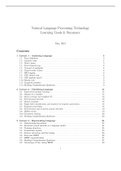College aantekeningen
College aantekeningen Natural Language Processing Technology Speech and Language Processing, ISBN: 9780131227989
- Instelling
- Vrije Universiteit Amsterdam (VU)
This summary provides information of all described learning goals and answers to the reading comprehension questions
[Meer zien]





